I m tempted to use simple copper straps to affix the pipes to the joists themselves.
Lots of pipes hang down under floor joists basement.
The way this works bruce takes his plumbers tape and attaches it to a joist runs the tape down through the piece of pipe standoff then around the drain line and back up through the standoff.
I would like to install pipe parallel to the floor joists in my basement and then conceal it behind drywall.
Step 3 understand the joist slopes.
So the otherwise flat ceiling has an 18 foot long section where the drywall is an inch lower than the surrounding drywall.
But they were run under the joists instead of through them as would be required by code for electrical wires.
The lower section is about 8 wide to accomodate the two pipes.
I figured i can just use a hole saw and make a notch in the joist for the pipe to sit and cover it with metal plate to prevent puncture.
Step 4 cut the holes.
The holes must follow a straight line across the floor and must ascend or descend so the pipe will be sloped 1 4 inch per foot.
Problem is that the current pipe all has a slope to it.
I want to finish my basement with a drywall ceiling.
The slope should be about 1 4 for each foot of pipe.
The holes will have to follow a straight line that goes across the floor and has to either go up or go down so the pipe has a slope.
Then he screws that to the joist and goes to the next piece.
Problem is that all of the hot water heat pipes hang below the joist and perpendicular to the joists.
If joists are 16 inches on center and pipes run across them at a right angle holes should differ in height by about 3 8 inch.
I need to do this with both gas black iron and domestic water copper pipe.

